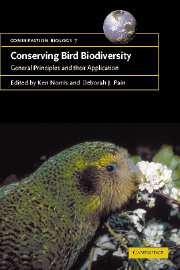Book contents
- Frontmatter
- Contents
- List of contributors
- Preface
- 1 Biodiversity – evolution, species, genes
- 2 Why conserve bird diversity?
- 3 Mapping and monitoring bird populations: their conservation uses
- 4 Priority-setting in species conservation
- 5 Selecting sites for conservation
- 6 Critically endangered bird populations and their management
- 7 Diagnosing causes of population declines and selecting remedial actions
- 8 Outside the reserve: pandemic threats to bird biodiversity
- 9 Predicting the impact of environmental change
- 10 Fragmentation, habitat loss and landscape management
- 11 The interface between research, education and training
- 12 Conservation policies and programmes affecting birds
- References
- Index
8 - Outside the reserve: pandemic threats to bird biodiversity
Published online by Cambridge University Press: 10 December 2009
- Frontmatter
- Contents
- List of contributors
- Preface
- 1 Biodiversity – evolution, species, genes
- 2 Why conserve bird diversity?
- 3 Mapping and monitoring bird populations: their conservation uses
- 4 Priority-setting in species conservation
- 5 Selecting sites for conservation
- 6 Critically endangered bird populations and their management
- 7 Diagnosing causes of population declines and selecting remedial actions
- 8 Outside the reserve: pandemic threats to bird biodiversity
- 9 Predicting the impact of environmental change
- 10 Fragmentation, habitat loss and landscape management
- 11 The interface between research, education and training
- 12 Conservation policies and programmes affecting birds
- References
- Index
Summary
INTRODUCTION
The identification of the most threatened species and the prioritisation of the most important sites for protection are, and will remain, essential to the conservation of bird biodiversity (Chapters 4 and 5). The uneven distribution of threatened biodiversity is highlighted by the fact that less than 5% of the Earth's land surface holds almost 75% of the world's threatened bird species (BirdLife International 2000).
On a global scale, however, protected areas are small; nationally protected areas cover less than 5% of the Earth's land surface and far less of marine habitats (Ryan 1992). It is generally accepted that site protection is inadequate to conserve existing populations of the majority of species whose ranges fall largely outside such areas (e.g. Pain & Dixon 1997). Some protected areas may even be insufficient to conserve those (often threatened) species for which they were designated. Relatively little work has been conducted on the long-term viability of such populations, especially important when reserves are isolated, although this is an expanding area of research (see Chapter 5). In addition, protected status is often nominal rather than actual, especially in areas where the needs of local communities are in real or perceived conflict with the objectives of environmental protection (Terborgh 1999).
Reserves cannot be viewed in isolation, as many activities and population processes taking place outside protected areas can adversely affect conditions for species within protected areas (e.g. Baillie et al. 2000).
- Type
- Chapter
- Information
- Conserving Bird BiodiversityGeneral Principles and their Application, pp. 157 - 179Publisher: Cambridge University PressPrint publication year: 2002
- 4
- Cited by

